Korean food is famous for its bold flavors and vibrant colors, but what about those watching their waistlines? Don’t worry, you can still enjoy the exciting world of Korean cuisine while keeping your calorie count in check. Let’s dive into the delicious world of Low Calorie Korean Food and discover how to indulge in your favorite dishes without the guilt.
 Colorful Bibimbap Bowl with Fresh Vegetables
Colorful Bibimbap Bowl with Fresh Vegetables
Light and Flavorful: The Hallmarks of Low Calorie Korean Food
The beauty of Korean cuisine lies in its emphasis on fresh ingredients, lean proteins, and minimal processing. This focus on natural flavors makes it surprisingly easy to find low calorie Korean food options that are both delicious and satisfying.
One of the key principles of low-calorie Korean cooking is the use of fermentation. Kimchi, a staple in Korean meals, is a prime example. This fermented cabbage dish is not only low in calories but also packed with probiotics that aid digestion and boost your immune system.
Navigating the Menu: Choosing Healthy Korean Dishes
When scanning a Korean menu, keep an eye out for dishes that prioritize vegetables, lean protein, and lighter cooking methods. Here are some healthy choices to get you started:
-
Bibimbap: This colorful dish is a nutritional powerhouse, featuring a bed of rice topped with an array of sautéed vegetables, lean protein (choose tofu or chicken for lower calorie options), and a dollop of gochujang (Korean chili paste). Ask for less rice or brown rice for an even lighter option.
-
Kimchi Jjigae (Kimchi Stew): This spicy and tangy stew is a Korean comfort food favorite. Opt for versions made with less pork belly and more tofu and vegetables to reduce the calorie content.
-
Japchae (Glass Noodle Stir-fry): These chewy, translucent noodles made from sweet potato starch are naturally low in calories. Japchae typically features a medley of colorful vegetables and lean protein, making it a light and flavorful choice.
Tips for Enjoying Low Calorie Korean Food
-
Pace Yourself with Banchan: Banchan, the small side dishes served alongside Korean meals, can be tempting. Choose lighter options like kimchi, seasoned spinach (sigeumchi namul), or bean sprout salad (kongnamul muchim).
-
Go Easy on the Sauce: While Korean sauces are delicious, they can also be high in sodium and calories. Use them sparingly or ask for them on the side to control your intake.
-
Share and Savor: Korean meals are often served family-style, encouraging sharing. Take advantage of this by ordering a variety of dishes and sampling smaller portions.
Frequently Asked Questions
Can I eat Korean food if I’m on a diet?
Absolutely! Korean cuisine offers plenty of healthy and delicious options. By choosing dishes with lean proteins, plenty of vegetables, and lighter cooking methods, you can enjoy the flavors of Korea while staying on track with your health goals.
What are some low-calorie Korean snacks?
Instead of reaching for chips or cookies, try these healthier Korean snacks:
- Dried seaweed snacks: These crispy, savory snacks are low in calories and a good source of iodine.
- Fresh fruit: Korea has a vibrant fruit culture, with delicious options like Korean pears, persimmons, and tangerines.
Is Korean food spicy?
Korean food is known for its bold flavors, including spice. While some dishes are quite spicy, there are also many mild options available. If you’re sensitive to spice, ask your server for recommendations or look for dishes marked as “mild” or “not spicy.”
Need More Guidance on Your Culinary Journey?
For additional support and information, don’t hesitate to reach out to our dedicated customer care team:
- Phone: 02437655121
- Email: [email protected]
- Visit Us: 3PGH+8R9, ĐT70A, thôn Trung, Bắc Từ Liêm, Hà Nội, Việt Nam.
We are available 24/7 to assist you.